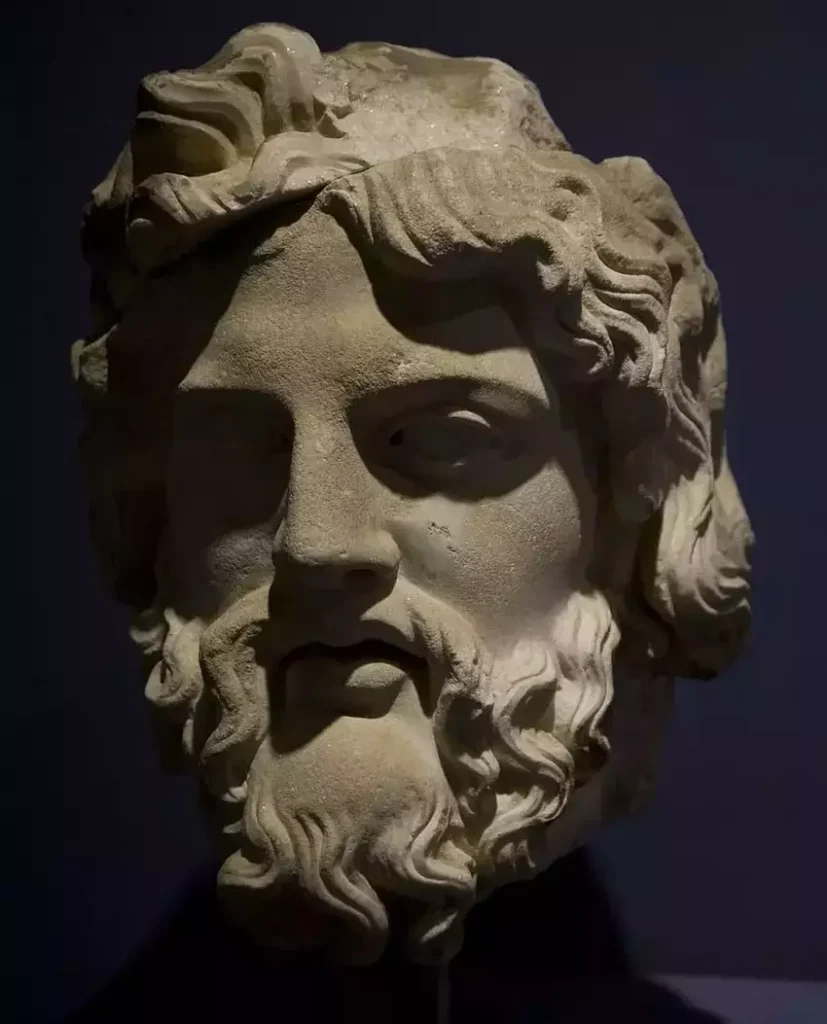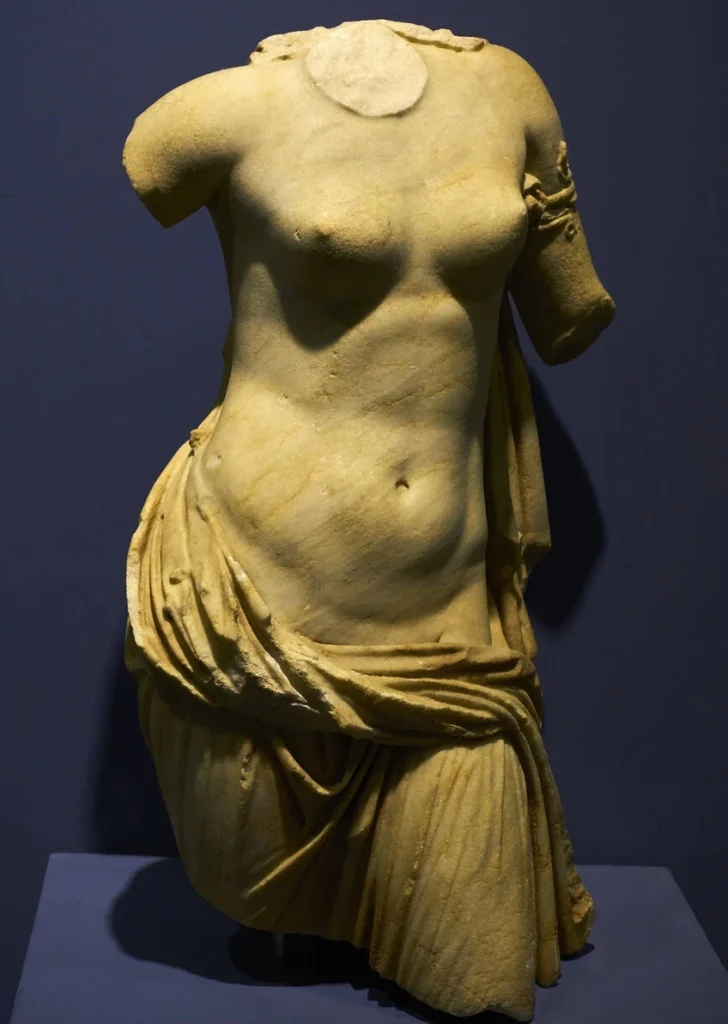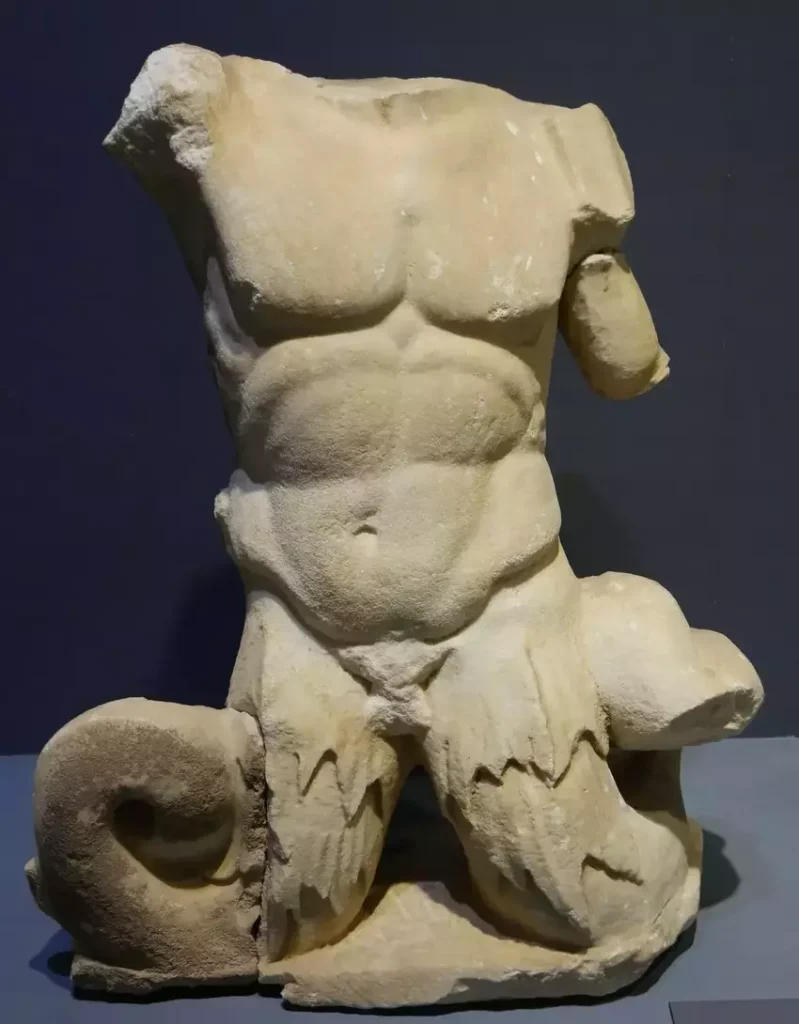Ephesus Archaeological Museum is situated in the center of Selcuk-Ephesus. It’s only 2 kilometers away from Ephesus Ancient City. The majority of the movable monuments discovered in Ephesus and the surrounding region before the First World War are now exhibited in museums located in centers such as the Vienna Ephesos Museum and the British Museum. Some of the monuments unearthed following the establishment of the Turkish Republic are exhibited in various museums in Turkey, while some others are exhibited in this local museum in Selcuk town. Although the artifacts in the Ephesus Archaeological Museum are not arranged chronologically, they are divided into halls.
As this article is lengthy and detailed, you can easily navigate using the table of contents below.
Table of contents
- Ephesus Archaeological Museum Vlog by Best Ephesus Tours
- 💵What is the entrance fee for the Ephesus Museum?
- Ephesus Archaeological Museum on Map
- The Hall of the Residential Relics
- The Hall of the Fountain Relics
- The Hall of the Recent Finds
- The Courtyard – Stone Artifacts
- The Hall of the Funerary Relics – Ephesus Archaeological Museum
- The Hall of Artemis – Ephesus Archaeological Museum
- The Hall of the Imperial Cults and Portraits
- You May Also Like
Ephesus Archaeological Museum Vlog by Best Ephesus Tours
A Brief History of the Ephesus Archaeological Museum
The Ephesus Archaeological Museum was established in 1929, but its collections expanded significantly following systematic excavations in Ephesus and its surrounding areas by the Austrian Archaeological Institute. Initially, the artifacts were displayed in the St. John complex, but as discoveries continued to multiply, a dedicated building was constructed in Selcuk in 1964.
💵What is the entrance fee for the Ephesus Museum?
The Entrance fee for the Ephesus Archaeological Museum in Selcuk is € 10 per person.
Ephesus Archaeological Museum on Map
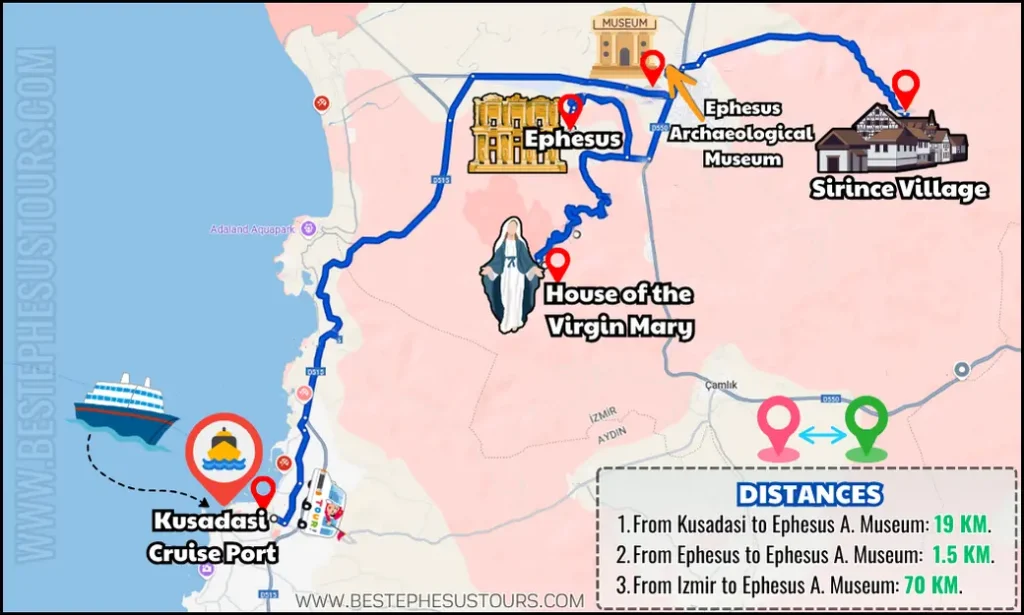
The Hall of the Residential Relics
Only a few of the houses in Ephesus have been excavated during the last one hundred years. All the houses consisted of a courtyard (peristyle) surrounded by small and large rooms. Some of them had two or three storeys. From the 1st century until the 7th century, the houses were modified without changing the original foundation to meet the demands of the day. Hence, the relics unearthed show great variation in terms of periods. Although the final collapse of the houses was due to an earthquake, no skeletons were discovered during the excavations. Most of the relics discovered in the houses were statuettes and busts of important personalities, such as emperors and priests, or small household items that were easy to carry.
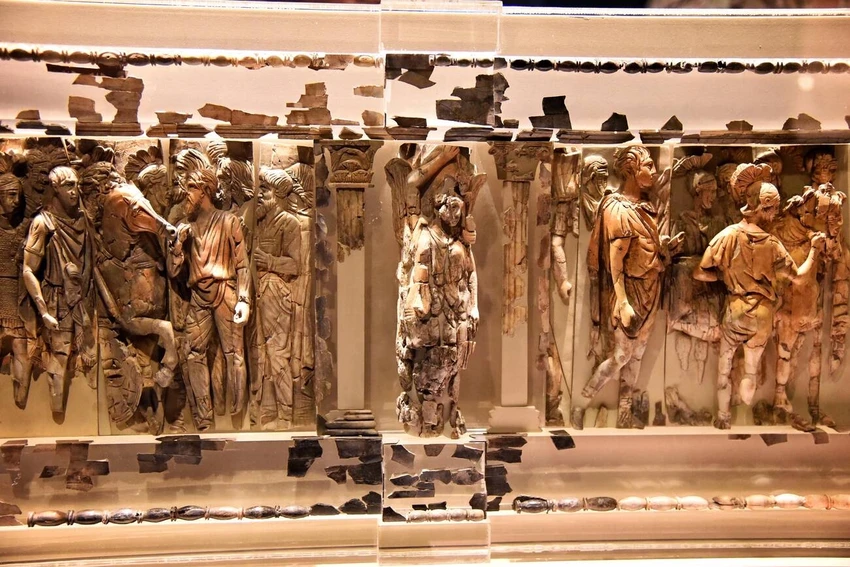
Until a few years ago, all the relics excavated had been brought to the museum to be displayed. However, during the last few years following the restoration of the houses, some of the relics have been exhibited on-site. Most of the relics seen today in the Hall of the Residential Relics were excavated during the last thirty years. The frescoes seen in this hall were discovered during the initial excavation of the houses. The frescoes as well as the mosaics found in the houses are exhibited on site.
The Hall of the Fountain Relics
During antiquity, fountains had an important place in urban architecture. They were built in significant locations in the city by wealthy people. They were decorated with statues and columns, and all of them had one or two pools in the front. Those built during the Hellenistic period were small but appealing, and the ones built during the Empire consisted of two levels and looked monumental. A small door connects the Hall of the Residential Relics to the Hall of the Fountain Relics. The first object to the right of the entrance of this Hall is the Bust of Zeus. Although it exhibits the characteristics of the Classical era, it was created during the Roman Empire (1st century). The bust consists of two pieces. The smaller one was discovered later and put in place.
Next to this is the marble statue of Aphrodite sculptured in ideal measurements. She is depicted naked above the hips, and both the head and the feet of the statue are missing. Both of these statues were created in the 1st century. The tall statue in the center is called the Resting Warrior, and it was located in the triangular frontal of a fountain. He is depicted holding a sword in his left hand and reclining toward his shield.
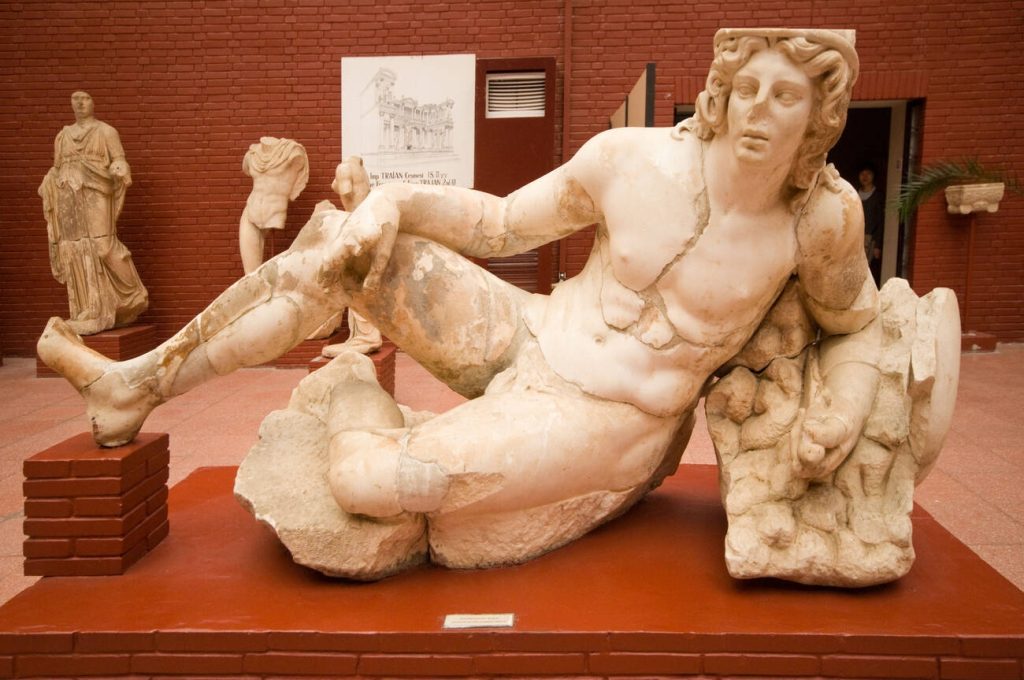
The Polyphemus Group is in the round niche on the left side of the hall. This group was originally located on the pediment of the Temple of Augustus, but later it was placed on the edge of the pool of the Fountain of Pollio. Poseidon’s son, Polyphemus, is depicted in the middle. There are corpses in front of the person he killed on his knees. On one side of Polyphemus, Odysseus and his friends are depicted bringing him wine, and on the other side, men are carrying the pole prepared to blind Polyphemus. This group was created in the 1st century.

Opposite the Polyphemus Group are the statues from the Fountain of Trajan. The first statue depicts young Dionysus with his head leaning against a log. In front of him, there are columns of the vine, and at his side, a satyr is depicted lying down. Placed side by side next to the wall are the statues of Dionysus and the members of the imperial family. They are depicted dressed. The diagram on the wall shows the original places of these statues on the Fountain of Trajan. The statues of the founder of Ephesus, Androklos, with his dog and Aphrodite, are in front of the diagram. Aphrodite is depicted semi-nude with a seashell covering her navel.

On the other side of the Hall are the statues from the Fountain of Laecanius Bassus, which is called the Aqua Palace. The one on the right, with feet like a sea serpent’s, is the statue of Triton, Poseidon’s son. The other two statues depict the Nymphs. The outline of their bodies shows under the garments they are wearing.
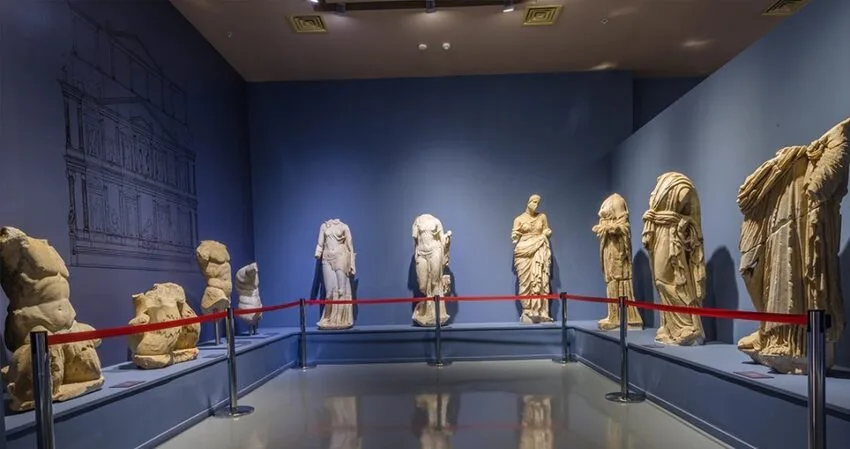
One of the busts on the wall is the Bust of a Warrior. He is shown bearded and wearing a helmet, and this bust dates from the Roman Empire. It is a copy of the 5th-century B.C. original. The other items are portraits and busts.
The Hall of the Recent Finds
The main entrance of the Hall is through the Hall of the Fountain Relics. Small objects dating to the Byzantine era are displayed in the built-in showcase to the right of this entrance. The bronze cross and the other relics shaped like a cross hanging on the white wall of the showcase are from between the 6th and 12th centuries. Saints and a crucified Christ are depicted on some of them. The off-white glazed bowls decorated with birds in the center are displayed on the floor of the showcase. They were made between the 10th and 12th centuries and decorated using the sgraffito technique.
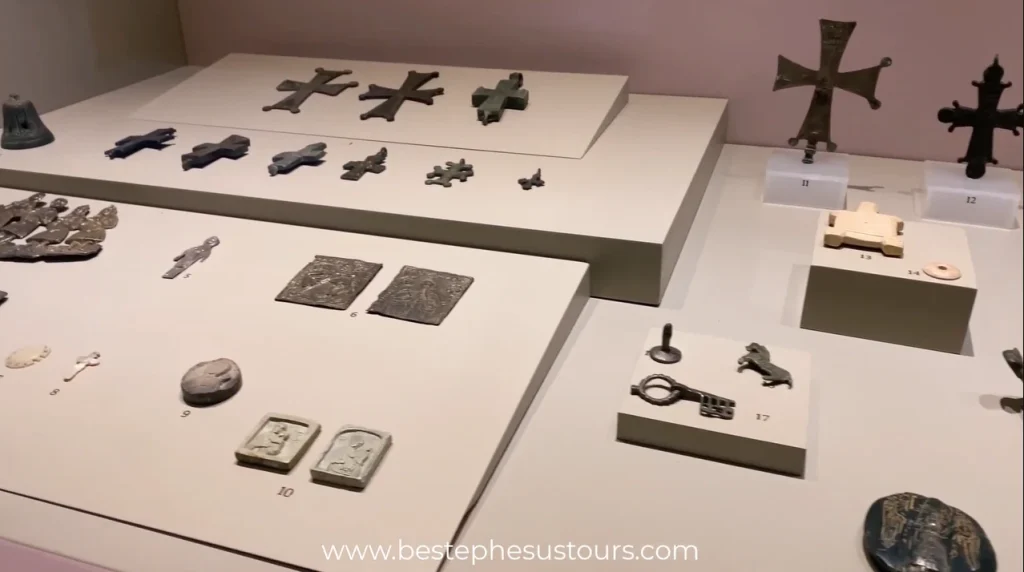
The fragment of an icon made of soapstone is ornamented with reliefs and exhibits high-quality craftsmanship. The figures on it are bishops. This type of icon, made of soapstone, made its appearance in the 10th century. On one of the two small square panels displayed in this showcase, the Virgin Mary is depicted with Christ, and on the other panel, the Virgin Mary is depicted alone. These two silver panels with reliefs were part of a box, and they are appliqued onto the wall. The dark green colored stone medallion is one of the most beautiful objects displayed in the showcase. On one side of the medallion, Michael is depicted with wings, holding the Cross in one hand and a book in the other. On the other side of the medallion, there is a man’s head in the center, and there are seven animals with ears, stretching their long bodies left and right. There is an inscription on each side of the medallion. Remember that you can explore the entire Ephesus Archaeological Museum in our Private Ephesus Tours, organized by Best Ephesus Tours.

The coins are kept in the next few showcases. A diagram on the wall describes the way a coin was made in Ephesus. Two coins of Ephesus, one bearing the figure of a bee, which is the symbol of Ephesus, and the other bearing a figure of Artemis, were enlarged and put on display here. Around the figure of Artemis is the inscription “Diana Ephesia’ and on the other coin are the first two letters of the word “Ephesus” in Greek. Only a certain number of the coins unearthed during the excavations are being displayed.
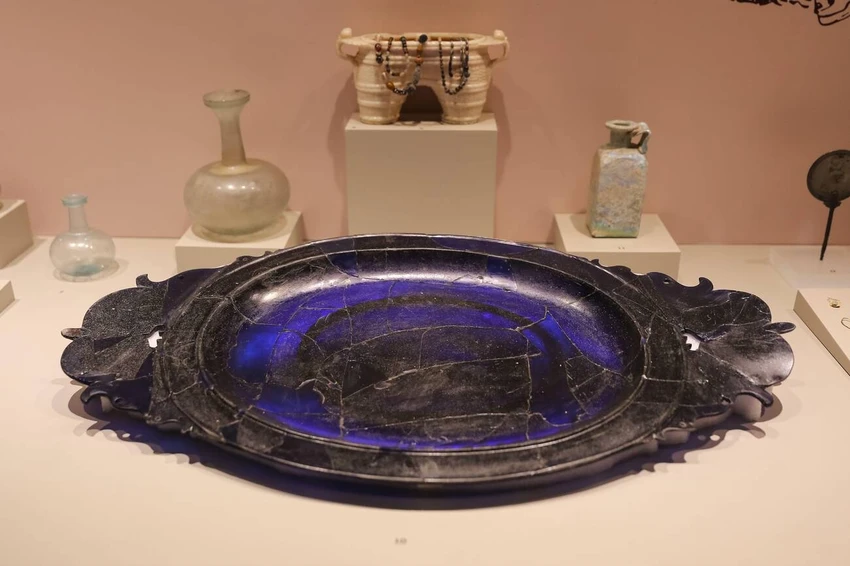
The glass tray, one of the most beautiful objects in all the museums in Turkey, is displayed in the showcase in a niche, following the coins. The oval tray is navy blue and has wide and rolled handles. It was made in the 1st century. Baked clay wine cups dated between the 6th and 2nd centuries B.C. are seen in the second niche. The hardened sediment in a bowl on display was found at the bottom of an amphora.
The head of the Bronze Serpent displayed in the second niche is missing. The snake depicted in motion was made to “protect” a house in the 1st century. It is covered with scales, and when examined closely, traces of gold plating can be seen.
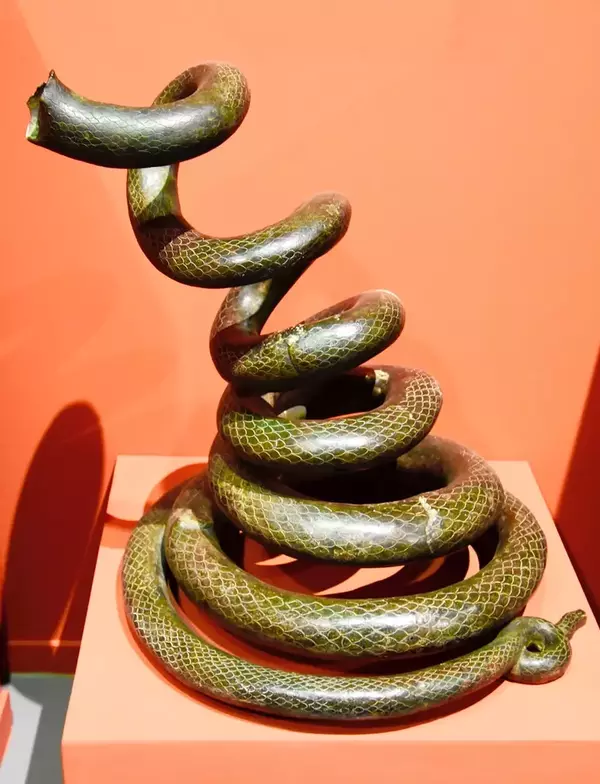
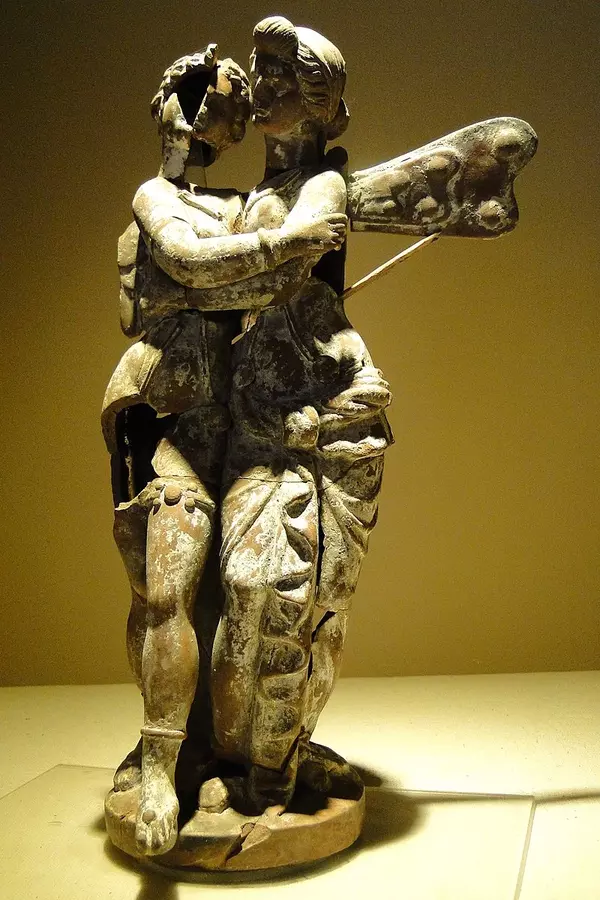
In the fourth showcase, there are two statues of Eros. In one, a nude Bros is depicted standing and holding a mask in his left hand. With his right hand, which is missing, he was holding the lizard seen at his feet by its tail. This statue was made to serve as the faucet of a fountain, and the water ran through the mouth of the mask. The other statue in the showcase depicts Eros on a dolphin, and it was also made as a faucet. This type of fountain decoration, popular even today, was used extensively in the Terrace Houses in Ephesus.
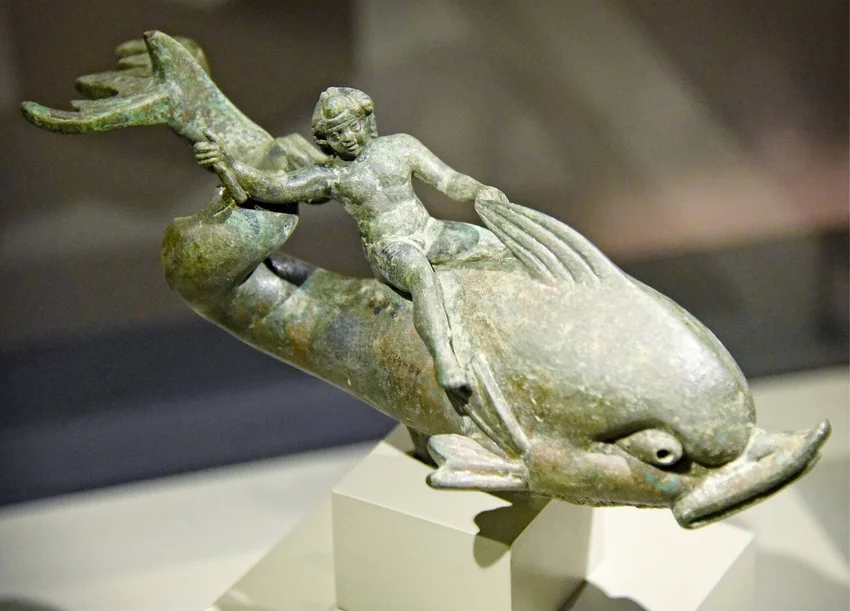
Moulds are displayed in the last niche. The way the decorations were appliquéd on a Skyphos (wine bowl) is explained in the upper section of the showcase. This type of appliqued ornamentation was first used in Pergamum during the Hellenistic period, and later it was also used in other cities. The discovery of a positive mould in Ephesus indicates that the same method was used here, too. Oil lamps and other negative moulds, together with their prints, are displayed in the lower section of the showcase. Moulds made of baked clay and soapstone are seen on the right side, and these were used to cast weights.

The masks symbolizing tragedy are displayed to the left of the entrance of the Hall of Recent Finds. These masks were discovered during the excavations carried out at the Theatre of Ephesus. The sketches on the masks indicate where they were used in theatres as decorations. Also, to emphasize the fact that the actors used masks during performances, in the sketches, the actors are depicted holding masks.

The oil lamp collection is the richest collection in the Ephesus Archaeological Museum. Most of the lamps discovered in the course of excavations were unearthed in the Cave of the Seven Sleepers. We know that during antiquity, different types of high-quality oil lamps were produced in Ephesus and exported. As in many other places, in the workshops in Ephesus, oil lamps were mass-produced using moulds. The way an oil lamp was made in Ephesus is described in sketches on the northern wall of the hall where oil lamps are displayed. In the slim built-in showcase in the middle, examples of the oil lamps discovered in Ephesus are displayed, and the development of oil lamps is described.
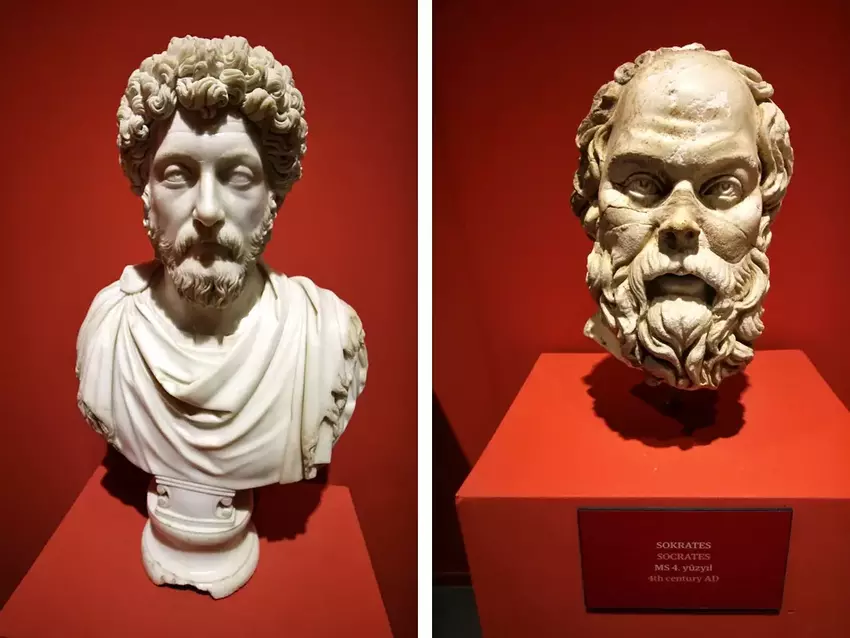
The bust of Emperor Marcus Aurelius is seen in the niche in the eastern wall of the hall. It was discovered in an excellent state of preservation in one of the Terrace Houses. The Emperor’s hair and beard are depicted with large curls, and he is wearing a paludamentum fastened by a fibula on the shoulder. The pose of Marcus Aurelius is not different from his other statues found in many other museums.
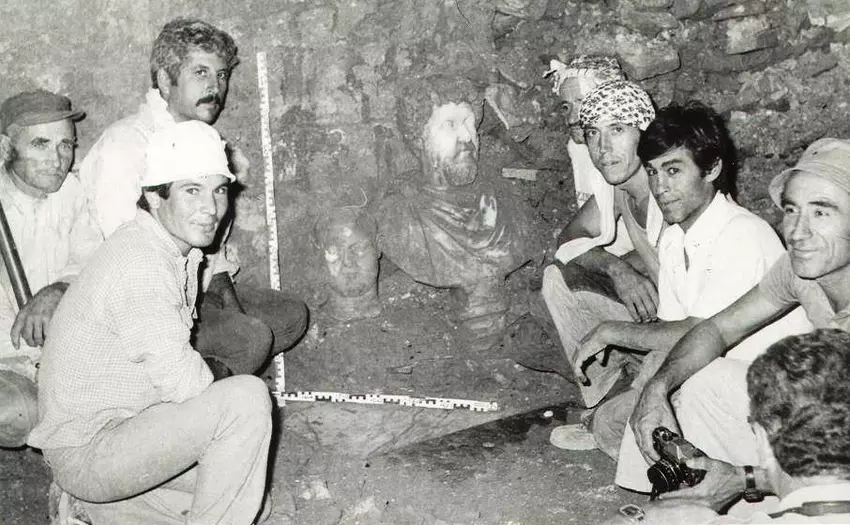
The Ivory Frieze, a rare treasure, is seen across the exit of the hall. It was found in 1969 in one of the Terrace Houses in Ephesus Ancient City. The battle between Emperor Trajan and the barbarians and the pre-war period are depicted on the frieze. The main segment of the frieze consists of three panels. The first caryatid on each side is depicted thinking, with one hand at her chin and the other hand at her waist. The other caryatid is in such bad shape that it is impossible to tell her pose. The two Nikes between. the panels are looking at Emperor Trajan. On the first panel, Trajan is depicted wearing a short robe, with a shield at his feet, and a horse in front of him. The Ivory Frieze is one of the most interesting artifacts in our Private Ephesus Tours.
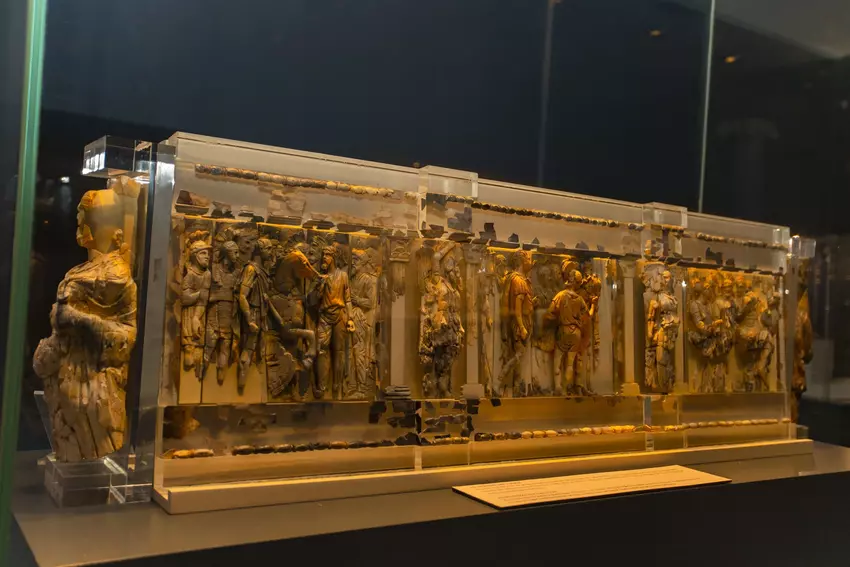
On the other side of the horse, there is a bearded figure wearing a long robe. He is presumed to be an important personality. Behind Trajan, there are Roman soldiers wearing war uniforms and carrying weapons. Behind the other figure, there are long-haired and bearded soldiers. In the middle panel, Emperor Trajan is depicted in high relief in the front. In front of him, there is a warrior wearing armor and a helmet, and he is about to give the horse to the Emperor.
Rows of Roman soldiers are seen in the background. In the third pane, there are three, presumably eastern, warriors, a horse in motion, and in the background, rows of warriors. Besides these main panels, there are panels with scenes that complete the pre-war and post-war themes. The panel on the right depicts a war and prisoners of war with their hands tied behind their backs. The frieze was created during the reign of Emperor Trajan. Depth is achieved by placing the figures in high relief in the foreground and those in low relief in the background.
The Courtyard – Stone Artifacts
There is a pediment on the southern wall of the courtyard, which is similar to the pediment on the Temple of Augustus in Ephesus. After it was restored to its original size, it was placed here to show the arrangement of the frieze used on the Fountain of Pollio in the temple. The sundial seen in the center is dated to the reign of Emperor Caracalla. It is spherical, consists of twelve segments, and bears an inscription.
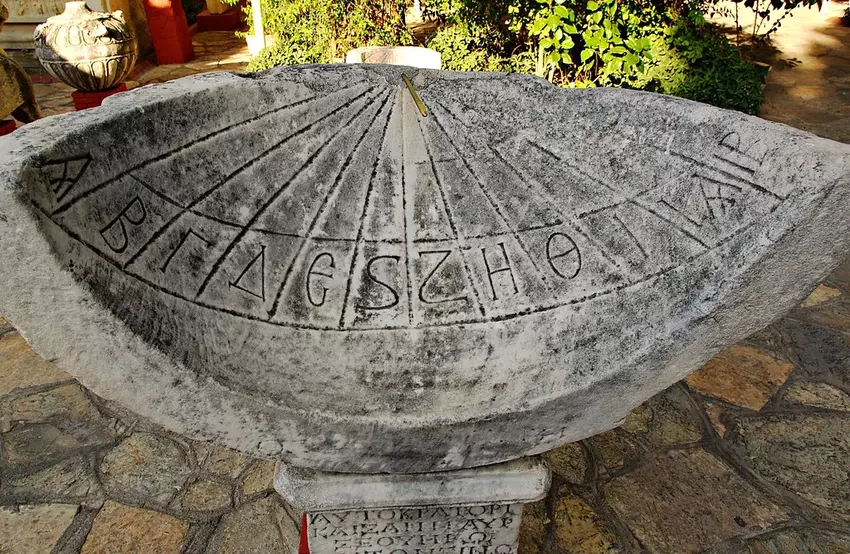
Column capitals are displayed in chronological order on both sides of the semi-covered area in the southern section of the courtyard. Ionic capitals dated to the 7th century B.C. are the oldest. The capital with a bull head on each side was unearthed in the Basilica. The dedicatory and grave steles found in various locations in Ephesus are displayed against the western wall. These belong to the Hellenistic era and the Roman Empire.
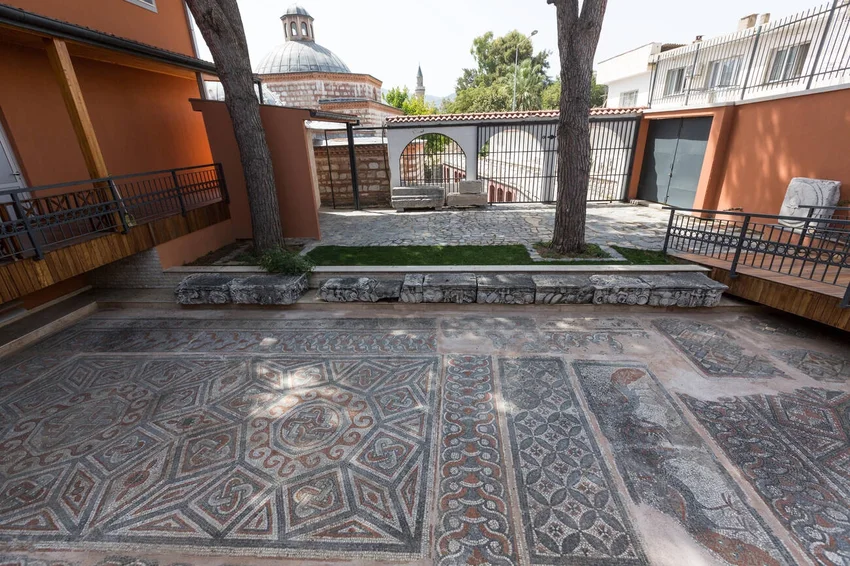
The well-preserved sarcophagus located in the western corner of the courtyard of the Ephesus Archaeological Museum was discovered near the Koressos Gate in Ephesus Ancient City. Muses, the goddesses of inspiration, are depicted in a row on the sarcophagus, which was used twice. Each Muse symbolizes a branch of the arts, like music, literature, theatre, etc. The large sarcophagus across from this was brought here from the Belevi Mausoleum, which was constructed in the middle of the 3rd century B.C.
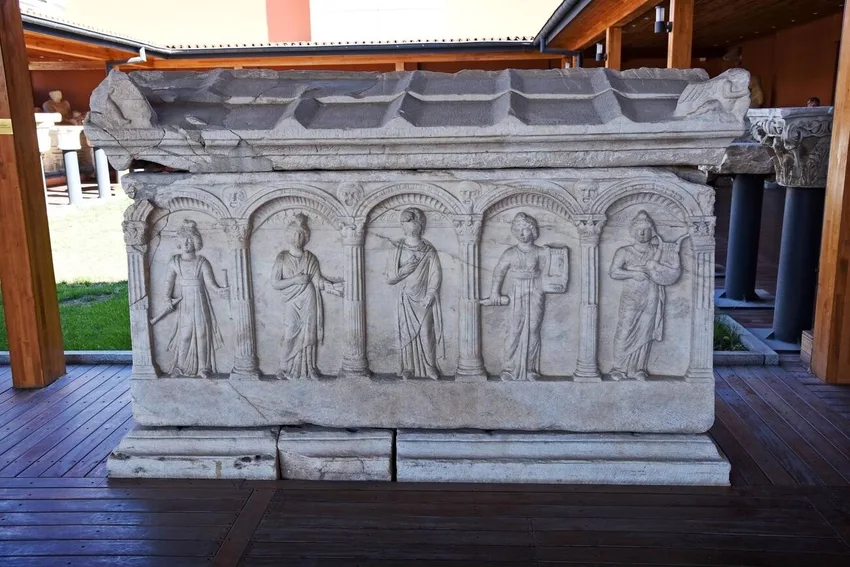
It is similar to the Mausoleum in Halicarnassus, considered one of the Seven Wonders of the world. The reclining figure on the sarcophagus was its owner. The griffons and the stone vase seen next to the sarcophagus originally decorated the roof of the Belevi Mausoleum. Behind the Belevi Sarcophagus, there is an inscription of 152 lines, which was unearthed during the St. John excavations. Later, it was used as part of an ambo. The inscription outlines the customs regulations announced on July 9, 62, during Emperor Nero’s reign. The rights of the revenue collectors in the Asian customs are listed. During the Roman period, customs and other revenues were collected not by civil servants as is done today, but by agencies that paid cash in advance to do the job. As in many other provinces, in the Asian province, the tax was equal to 2.5% of the value of the goods. The text of the inscription describes customs procedures.

Travelers were required to show their belongings to the customs official. For example, a 5% luxury tax was charged for a purple dress. Food and anything else produced for the army, the Roman state, and the emperor were exempt from customs. Personal clothing, transportation vehicles, and slaves used as servants were also exempted from taxation. Slaves were considered trading goods, and they were subject to a “head tax”.
The Hall of the Funerary Relics – Ephesus Archaeological Museum
The cemetery in Ephesus Ancient City has not been excavated yet. The objects found in the graves discovered by chance in the course of excavations are exhibited in this hall of the Ephesus Archaeological Museum. Until the Byzantine era, it was traditional to place gifts in the graves, but during Christianity, this tradition started to wane. The social status of the deceased, his financial situation, and his rank influenced the size of the tomb built for him and the value of the gifts placed in these tombs. On the right side of the hall, there is a sketch describing traditional burial ceremonies in Anatolia. Popular types of graves from the Old Bronze Age up to the Seljuk era are shown in the sketch. The oldest grave unearthed in Ephesus is a Mycenaean grave found by chance on the grounds of the Church of St. John. Gifts discovered in the grave were dated between 1400 and 1300 B.C. They are on display in the first showcase in this hall of the Ephesus Archaeological Museum.

The most popular type of sarcophagus during the Archaic period was made of baked clay and is referred to as the Klazomenai-type. Klazomenai was an ancient city west of Izmir, and since this type of sarcophagi was discovered here for the first time, they are referred to as the Klazomenai type. They were discovered during exploratory diggings carried on at the Agora (marketplace) of Ephesus Ancient City. A Klazomenai-type sarcophagus dated to the 5th century B.C. is displayed with the gifts in the Ephesus Archaeological Museum, in the center of the hall. Some of the objects discovered in this type of sarcophagus are displayed in the second showcase.
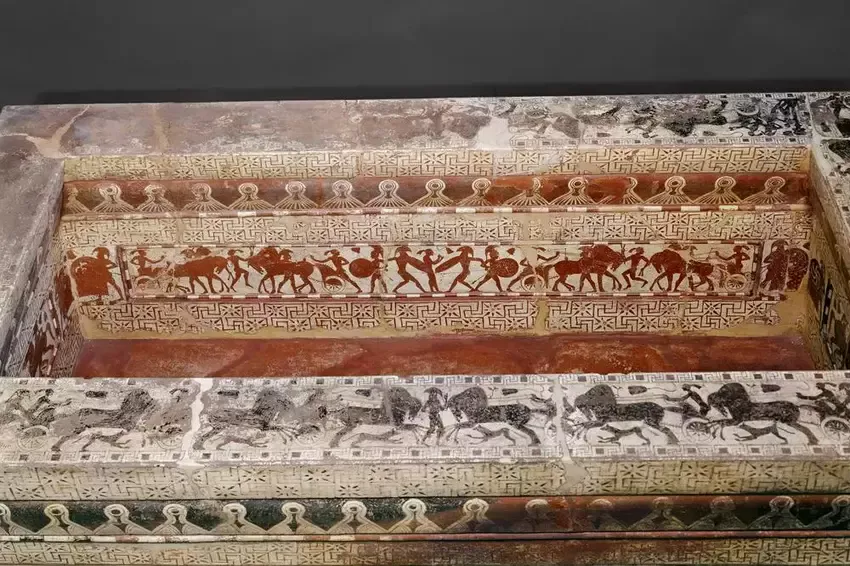
The Cave of the Seven Sleepers was like a very popular cemetery during the early Christian era. Many graves on top of each other were found here ,where resurrection took place. Some of the objects discovered in this cave are displayed, along with the story of the seven sleepers, on the eastern wall of the hall. The picture seen on the right is an enlarged copy of a 16th-century miniature presently on display in the Museum of Turkish and Islamic Art in Istanbul. The miniature depicts the Muslim version of the story of the Seven Sleepers and their dog, Kitmir. The other drawing made in the 10th century was taken from the Saint Calendar of Basileus Il, found in the Vatican. Here, the seven Christians, dressed according to the fashion of the day, are depicted sleeping.
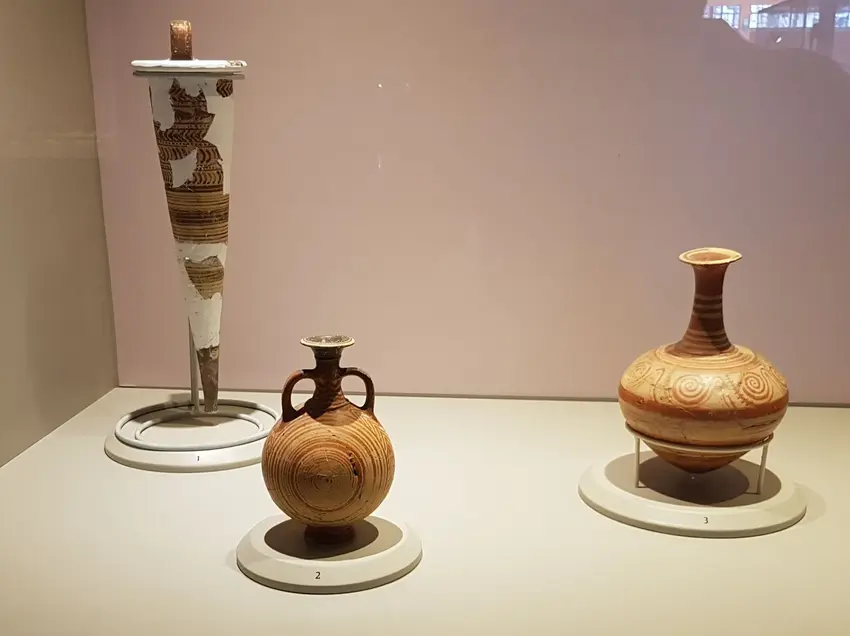
Multi-colored glass treasures seen in the showcase, where the glass objects are displayed, are known as Phoenician glassware. Some of these were discovered in Ephesus Ancient City in the graves belonging to the Archaic period, and the others belong to the late Hellenistic era and the Roman age. The bracelets seen in the lower section of the showcase belong to the Byzantine era.
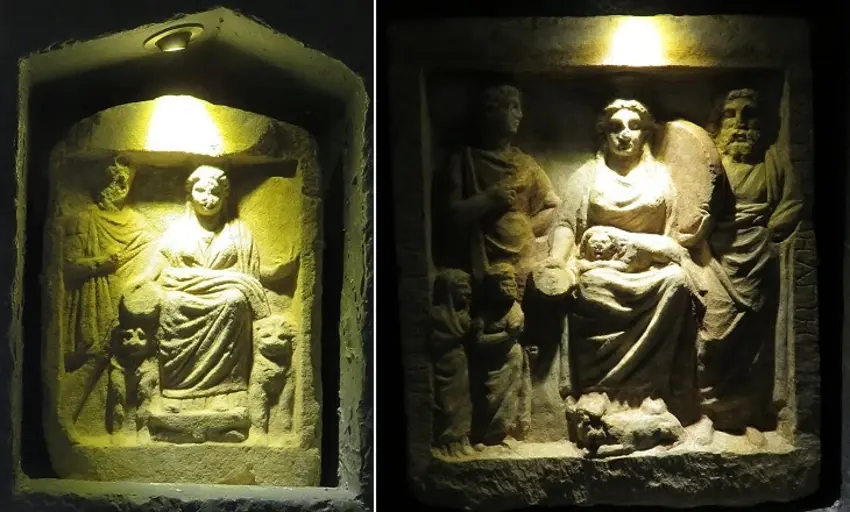
In the corner with a niche, the evolution of the mother goddess in Anatolia is described. The Statue of Cybele seen in the niche is typical of other statues of Cybele found in museums in Turkey. She is depicted sitting on her throne with her lions on both sides of her. The statue was made in the 6th century B.C… The others are steles of Cybele and have frontals. Cybele, Attis, and Zeus are depicted together on these steles.
The main centers of the mother goddess in Turkey are indicated on the map next to these. Some of the treasures displayed in the built-in showcase next to this were found in a well (probably a wishing well) located in the southwestern corner of the state agora of Ephesus. Most of these objects belong to the 1st century B.C.
The Hall of Artemis – Ephesus Archaeological Museum
The statues of Artemis and the objects found at the temple and the altar of Artemis are displayed in this hall. On opposite sides, the two most famous statues of Artemis in the Ephesus Archaeological Museum are displayed. The one in the west is 2.92 meters tall and is known as the Great Artemis, and the other in the east is known as the Beautiful Artemis. Both of them were discovered at the Prytaneion (the administrative building) in Ephesus, in an excellent state of preservation.

The Great Artemis is Asiatic looking. The lions on both sides of Cybele had been diminished in size and placed on her shoulders. Her legs seem fused, and her arms are stretched forward as though she is distributing fertility. With the gravity of a true goddess, she is looking beyond. The crown she is wearing has three tiers. Three Ionic temples, each with four columns in the facade, are seen on the uppermost tier, and griffons and sphinxes carrying arches are seen on the lower tiers. On each side of the moon behind her, there are five lions and bull griffons. Her eyes are big, and her facial features are full. She wears earrings and two rows of necklaces.
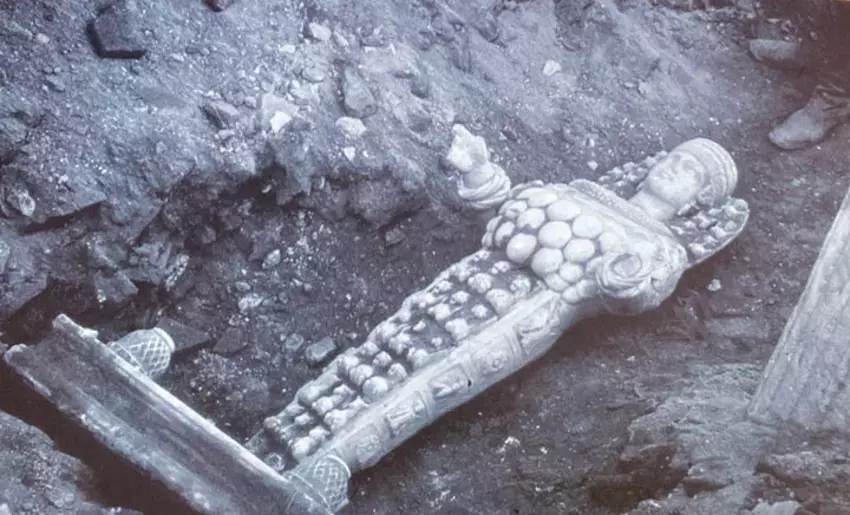
There are four rows of nodes in the lower section of her chest. At first, these were assumed to be her breasts, then eggs, and according to a recent theory, they represent the testes of the bulls sacrificed for the goddess. All these are based on the idea of fertility and reproduction. Although the goddess was a virgin, she was the protectress of women giving birth. Her forearms are broken. The hole seen in her right arm could have been made either during a repair in antiquity or to attach the arm made of precious metal, like gold.

During antiquity, the goddess used to be dressed in clothes made of very valuable fabrics, and only her face and arms were exposed. Therefore, her hands may have been made of gold. She is wearing a narrow belt decorated with motifs of a rosette made of four segments and a bee (symbol of Ephesus). The base of the statue is missing. Her skirt, which hangs straight, is separated into rectangles by horizontal and vertical lines. In each rectangle, there are figures of animals such as lions, bulls, deer, rams, griffons, and bees. There are six rectangles in each row. On the sides of her skirt, there is only one figure in each rectangle. In the middle rectangle of the first five rows, there are three figures, and in the middle rectangle of the sixth row, there are two figures. The statues of Artemis are one of the most interesting artifacts of our cruise guests participating in our Ephesus Shore Excursions.

The Great Artemis was made in the 1st century A.D. The Beautiful Artemis, which stands 1.74 meters tall, was made about 50 years after the Great Artemis and resembles it. It was made from better-quality marble. It is whiter, well-glazed, and gold-gilded. Traces of the gilding can be seen only on the right side of her neck. Her crown is missing. Figures of Nike decorate the upper section of her necklace, which resembles strands of pearls, and signs of the zodiac decorate the lower section of her necklace. Her skirt narrows towards her feet, and only the tips of her toes are exposed. Her sacred animals, deer, are seen on both sides of her.
There is another small statue of Artemis next to the statue of Beautiful Artemis. The head of the statue is missing, and on her chest are the figures of Nike and signs of the zodiac. Both statues were created at about the same time.
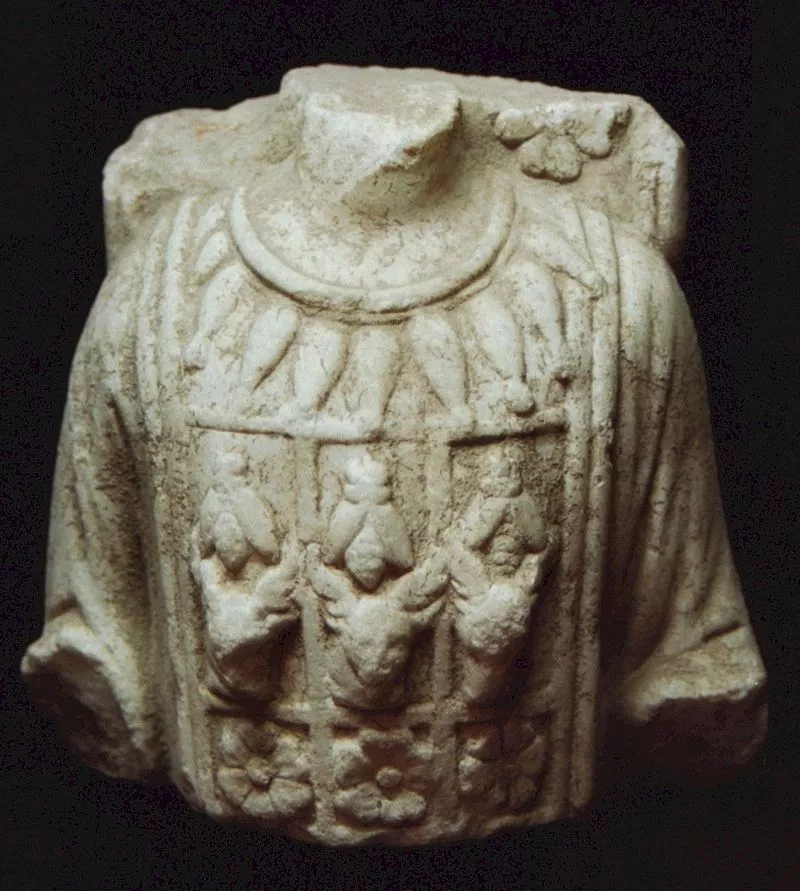
The Torso of Artemis, seen in the showcase, was unearthed during the excavation of a street. Dated to the 1st century B.C., this statue of Artemis bears three figures of either bull or deer heads on her chest.
The Gold Statue, which is seen in the showcase, is dated to the 7th century B.C. and it belongs to a goddess. It was discovered during the excavation of the Artemision. There are many ivory statues that resemble this statue. The votive offerings, which look like crystal wine goblets, are actually made of rock crystal. There are very few of these in the museums of the world. The baked clay, marble, ivory, bronze, and gold objects in the showcase were made between the 7th and the 5th centuries B.C. and were offered to the temple. The ivory statuette of a ram is Cimmerian.
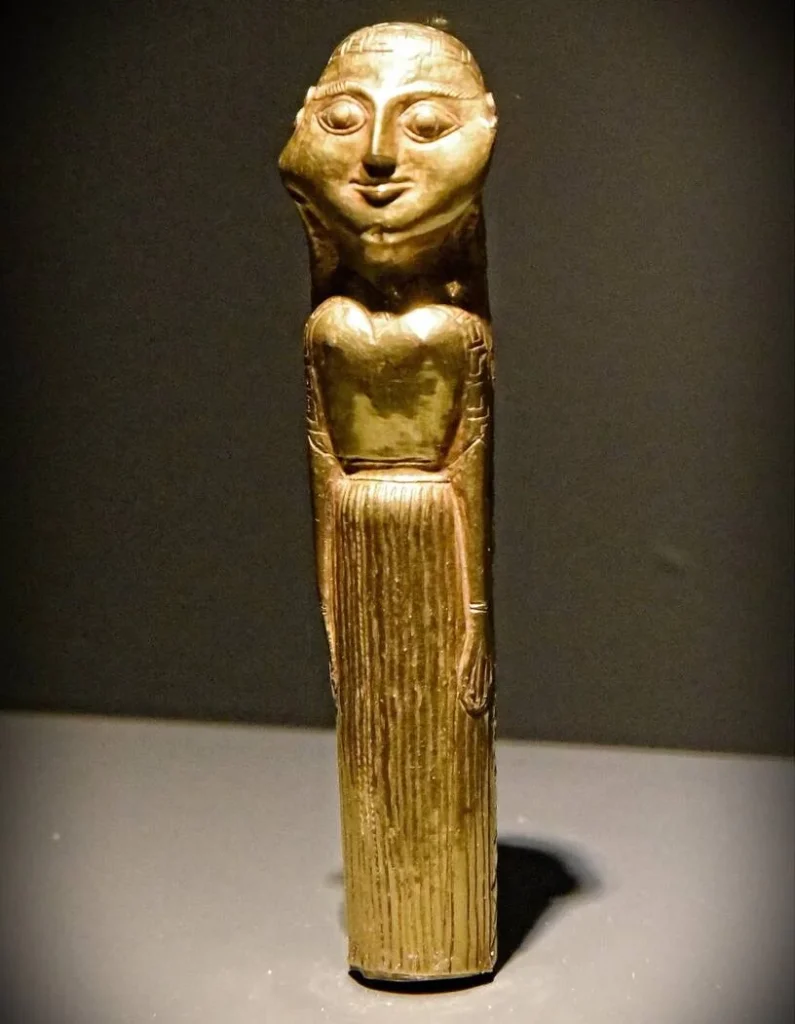
The statue of a horse is one of the four horses on a statue of a quadriga (a chariot drawn by 4 horses) created in the 4th century B.C. The quadriga was discovered on the altar of Artemis. The architectural elements of the temple are placed according to their original order.
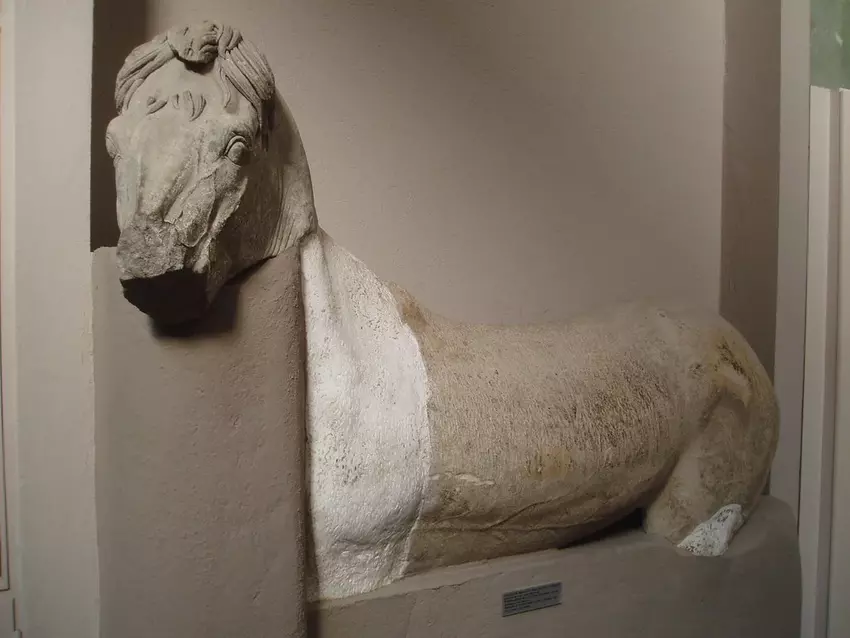
The Hall of the Imperial Cults and Portraits
The Roman period was the golden age of Ephesus. The most important monuments in the city were built during the Roman Empire, when Ephesus, as a neokoros, established its superiority four times over the rival cities of Samos, Pergamum, and Smyrna.
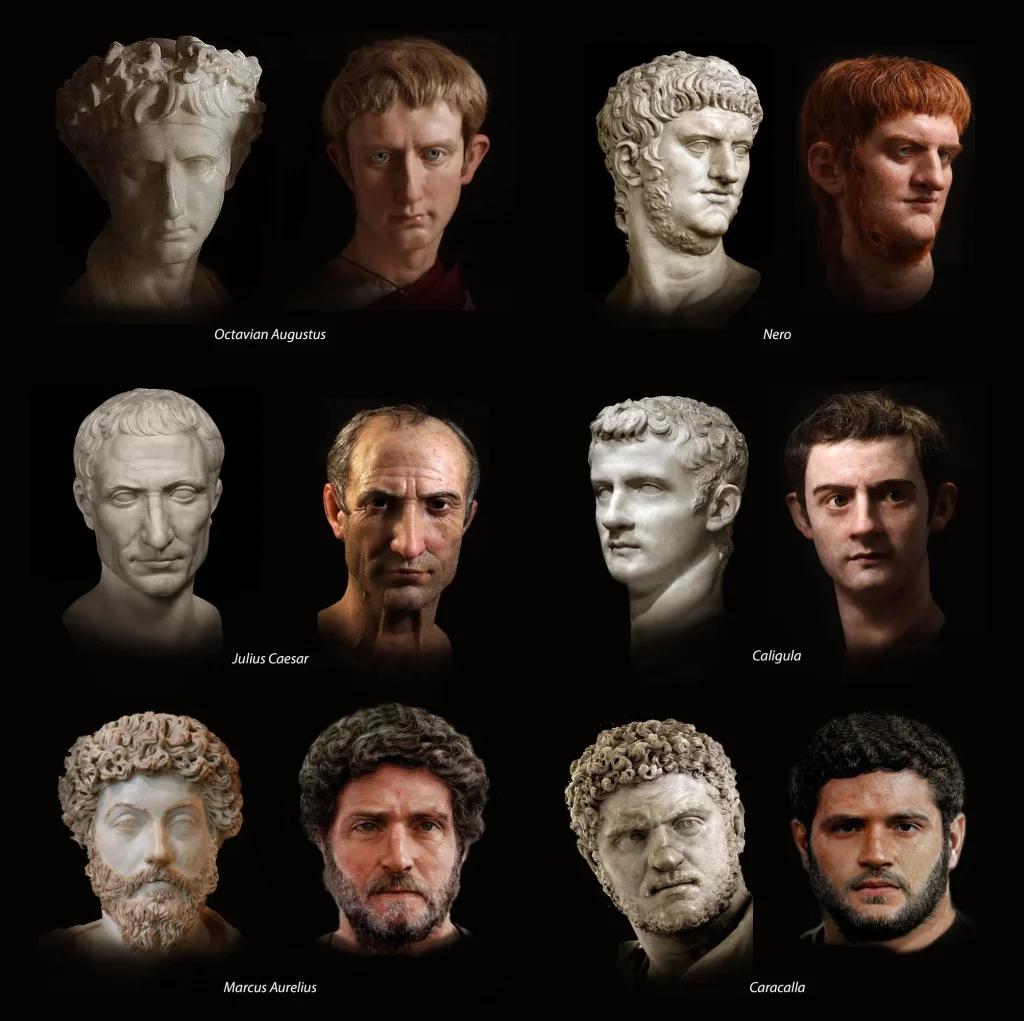
Except for the Temple of Domitian and the Olympeion, which was built after Hadrian returned from Athens to Ephesus under the name of Zeus Olympios, the location of the other imperial cult temples is not known. Excavation of the Temple of Domitian has been completed, but the excavation of the Olympeion, located next to the Church of the Virgin Mary, is still underway. Since this eighth-largest temple in the world was used as a stone and lime quarry during the first years of the Byzantine era, nothing but a 2-meter-high Corinthian column capital was discovered here.
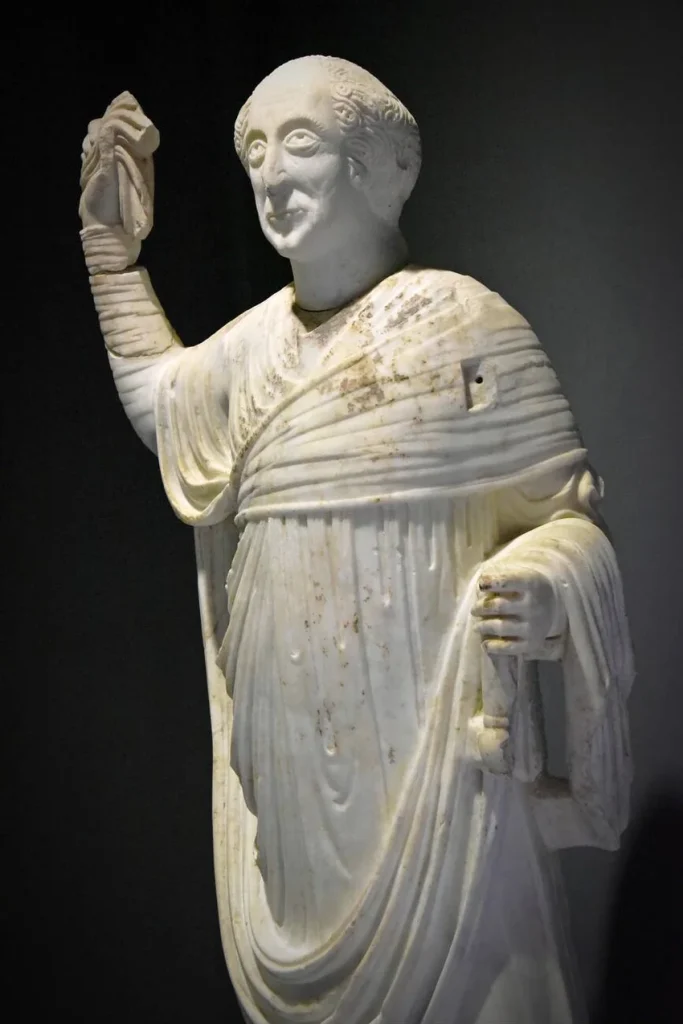


The 6th-century statue seen by the wall on the left upon entering through the Hall of Artemis belongs to Proconsul Stephanos. He is depicted holding a scepter in one hand and a handkerchief in the other, which is raised as though he is about to signal the start of a game or a race. The first of three portraits displayed on the wall on the side of the Hall of Artemis is of a half-breed and was made in the 3rd century. The other two were made during the same period, and they must be the portraits of distinguished citizens of Ephesus. The other portraits displayed on the same wall are also from the 3rd century and show the characteristics of the age.
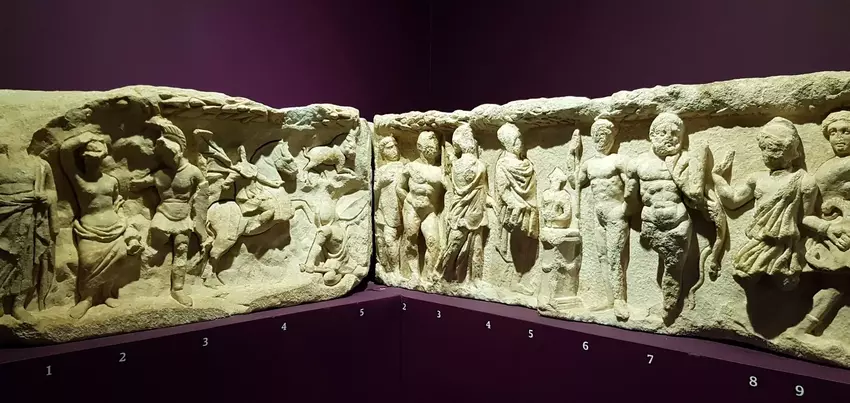
On both sides of the picture of the Temple of Hadrian, the frieze of the temple is exhibited. It consists of four sections. In the first three sections on the left, a few gods and goddesses with Androklos following the boar, gods and Amazons, Amazons, and a Dionysiac procession are depicted. However, the theme depicted in the fourth section is different. Here, starting from the left, Athena, Selena, an unknown man, Apollo, an unknown woman, Androklos, Heracles, Theodosius’ father, Emperor Theodosius, Artemis, the Emperor’s wife and son, and Athena are depicted in a row.

The statues of Augustus and his wife Livia are at the exit of the hall. The last panel was placed here during the restoration in the 4th century. The heads seen behind the frieze belong to the Roman period and were made between the 1st and the 3rd centuries.
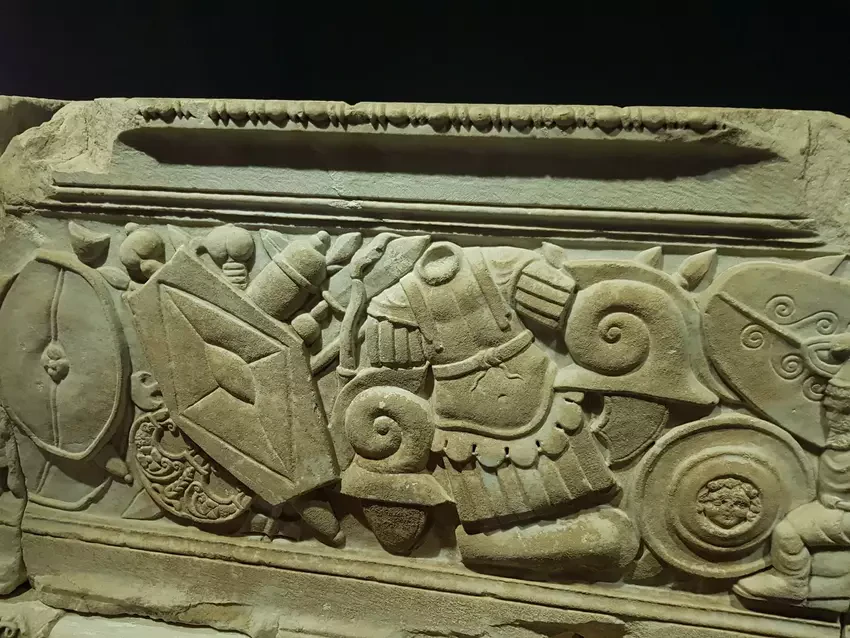
The altar in the center is part of the altar of the Temple of Domitian. There is the relief of a sacrificial bull on one end, and the relief of a weapon and armor on the side.
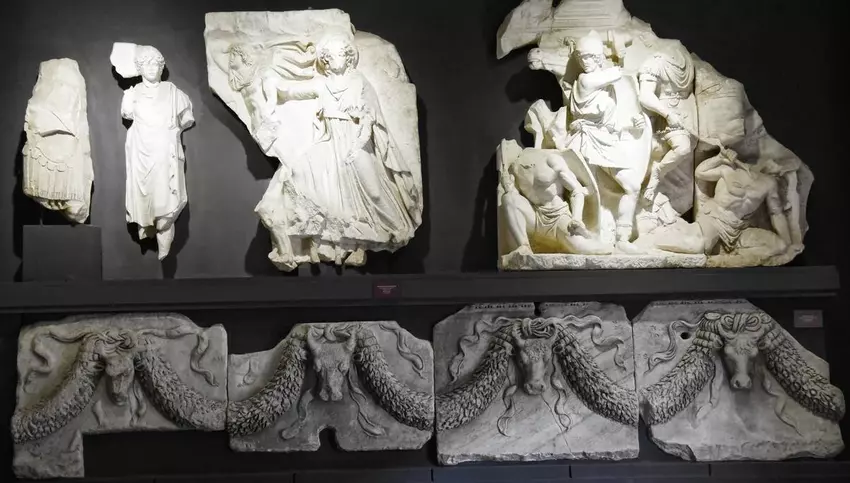
In the last hall of the Ephesus Archaeological Museum, known as the Hikmet Gürçay Art Gallery, the works of contemporary artists are exhibited from time to time.
You May Also Like
You can reach us at the links below if you would like to explore the Ephesus Ancient City, Museum, and Sights Around with Best Ephesus Tours.
Ephesus Shore Excursions from Kusadasi Port


